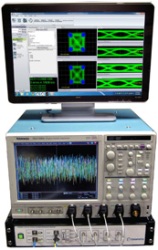Tektronix, Inc. has recently announced that its DPO72004B series oscilloscopes along with Optametra’s coherent light wave signal analyzers OM4105 and OM4106 are capable of real-time measurement and visualization of coherent and polarization-multiplexed quadrature phase shift keying (PM-QPSK) signals.
 Optametra’s Coherent Light Wave Signal Analyzer
Optametra’s Coherent Light Wave Signal Analyzer
The solution will be showcased at the OFC/NFOEC conference during March 23–25, 2010, in San Diego by Optametra and Tektronix jointly. OFC/NFOEC is a leading conference for networking and optical communication professionals worldwide.
Fiber impairments cause extensive increase in signal distortion when optical transmission rates exceed 10Gb/s. The industry is adopting a complex modulation scheme that combines PM-QPSK and coherent detection to tackle this problem. This scheme enables carriers to drastically increase data rates on current fiber infrastructure.
Testing of PM-SPSK signals poses considerable challenges and requires a sophisticated modulator and demodulator, as well as capturing of signals simultaneously on four channels in real time. Signal analyzers from Optametra, when combined with 20GHz Tektronix oscilloscopes, emerge as the only commercial tools for measuring and displaying the entire optical field of coherent signals at such high bandwidths. Optametra’s solution utilizes a computational engine that is based on an open-architecture MATLAB to provide quadrature and in-phase eye diagrams, bit-error ratios (BER), data waveforms, and constellations for light polarization in fiber as well as record/playback. Instrument functions that are frequently utilized are controlled by a graphic user interface.
Optametra has purchased the DPO72004B oscilloscope from Tektronix to help its customers who make 100G optical measurements. Customers of Optametra, in turn, have also purchased this Tektronix oscilloscope since they require a high-speed, real-time acquisition system having a high degree of signal integrity across all the four channels. Optametra’s engineering division vice president Daniel van der Weide revealed that its OM4000 series analyzers capture the entire electric field present in an optical signal at 112 GB/s, due to low floor noise, fast rising times, and flat frequency response features of Tektronix instruments. Weide has further elaborated that collaboration with Tektronix has helped Optametra to empower its customers to install, monitor, and characterize complex modulation receivers on the test bench, in the field, and on the floor.
Tektronix’s four-channel DPO70000B Series oscilloscopes have integrated 20GHz bandwidth, which is highest in the industry, with highest waveform capture rate and best signal fidelity. These oscilloscopes simultaneously offer support on all four channels to ensure deep memory and fast sample rate.
The general manager of the Performance Oscilloscopes business of Textronix, Brian Reich, further explained that the use of DPO72004B series oscilloscopes to precisely visualize and evaluate state-of-the-art 100G sampling process is another example for Tektronix’s leadership in the oscilloscope domain. Reich said that customers can work with Optametra to benefit from a transparent and comprehensive solution that makes complex measurements in fiber-optic solutions easier in the long run.